Mexicans Make It Clear Once Again How They Feel About Paying for Trumps â€ëœgreat Wall
Along the U.Due south. United mexican states almost Nogales, Arizona Getty Images
August 2017The cheerful paintings of flowers on the tall metallic posts on the Tijuana side of the border fence between the U.S. and Mexico confute the sadness of the Mexican families who have gathered there to exchange whispers, tears, and jokes with relatives on the San Diego side.

Many have been separated from their family members for years. Some were deported to United mexican states afterward having lived in the United states of america for decades without authorization, leaving behind children, spouses, siblings, and parents. Others never left United mexican states, simply have made their manner to the fence to see relatives in the United States. With its prison–like ambient and Orwellian name—Friendship Park—this site is i of the very few places where families separated past clearing rules tin take even fleeting contact with their loved ones, from 10 a.m. to two p.m. on Saturdays and Sundays. Elsewhere, the tall metal barrier is heavily patrolled.
And then is to be the wall that President Donald Trump promises to build along the border. Just no matter how tall and thick a wall will exist, illicit flows will cross.
Undocumented workers and drugs will still detect their way across any barrier the administration ends up edifice. And such a wall will be irrelevant to those people who become undocumented immigrants by overstaying their visas—who for many years have outnumbered those who become undocumented immigrants by crossing the U.S.–United mexican states border.
Nor will the physical wall enhance U.S. security.
The border, and more broadly how the Usa defines its relations with Mexico, directly affects the 12 million people who live within 100 miles of the border. In multiple and very meaning means that have not been acknowledged or understood it will also affect communities all across the United States also every bit Mexico.
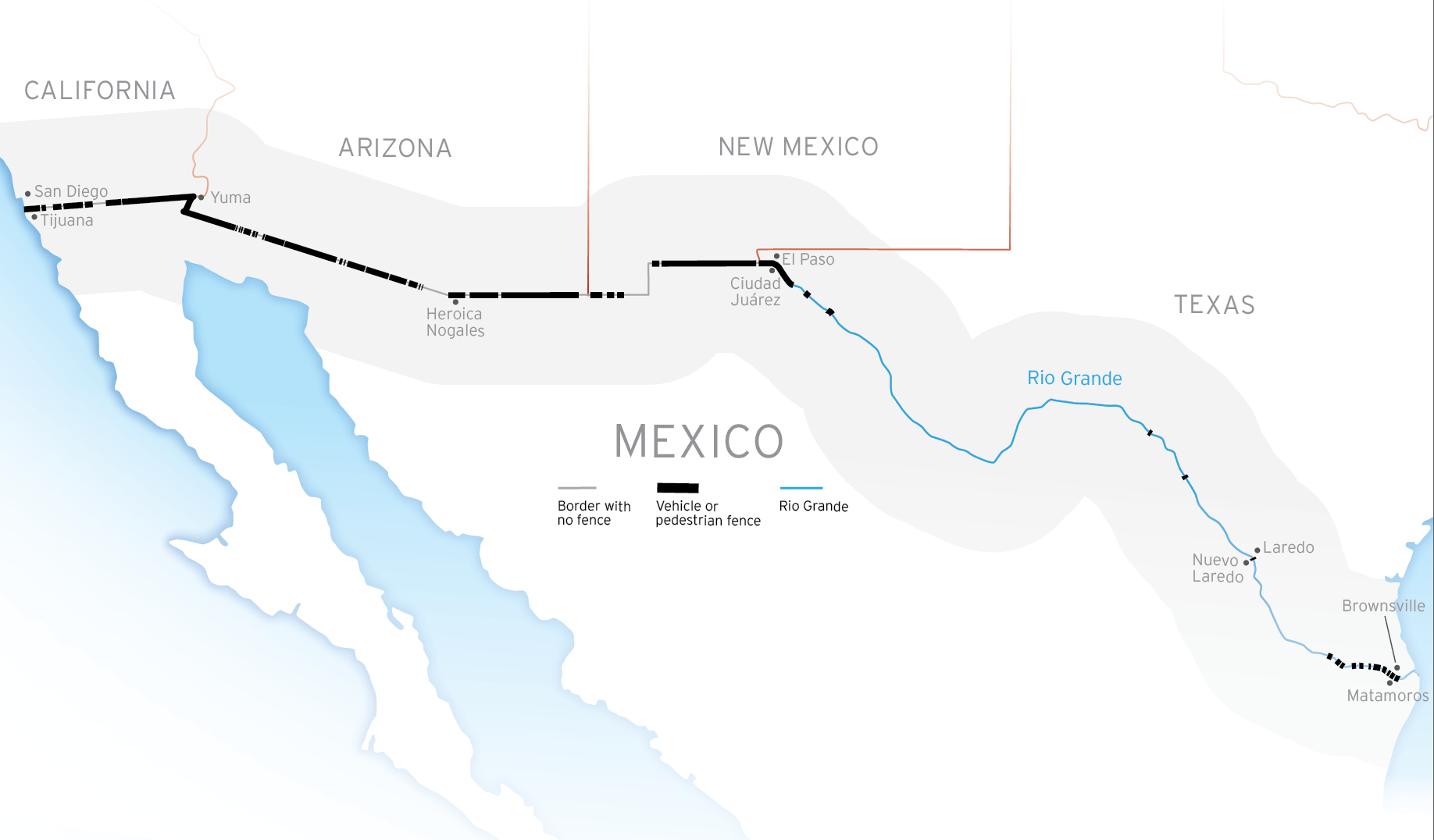
What the wall'due south price tag would be
The wall comes with many costs, some obvious though hard to judge, some unforeseen. The most obvious is the large financial outlay required to build it, in any form it eventually takes. Although during the election campaign candidate Trump claimed that the wall would toll only $12 billion, a Department of Homeland Security (DHS) internal report in February put the cost at $21.half-dozen billion, only that may be a major underestimate.
The estimates vary then widely because of the lack of clarity near what the wall will actually consist of across the beginning meager Homeland Security specifications that it exist either a solid concrete wall or a encounter–through structure, "physically imposing in summit," ideally 30 feet loftier only no less than 18 feet, sunk at to the lowest degree 6 anxiety into the basis to prevent tunneling under it; that information technology should non be scalable with even sophisticated climbing aids; and that it should withstand prolonged attacks with touch tools, cutting tools, and torches. But that clarification doesn't brainstorm to embrace questions most the details of its physical construction. Then there are the legal fees required to seize country on which to build the wall. The Trump administration can use eminent domain to acquire the land but will still have to negotiate compensation and oftentimes face lawsuits. More than than 90 such lawsuits in southern Texas alone are all the same open up from the 2008 endeavor to build a fence there.
The Trump assistants cannot only seize remittances to Mexico to pay for the wall; doing then may increase flows of undocumented workers to the United States. Remittances provide many Mexicans with civilities they could never beget otherwise. Only for Mexicans living in poverty—some 46.2 percent in 2015 according to the Mexican social enquiry bureau CONEVAL—the remittances are a veritable lifeline which tin can correspond as much as eighty percent of their income. These families count on that coin for the basics of life—food, clothing, health care, and instruction for their children.
The remittances enable human and economic development throughout the country, and this in turn reduces the incentives for further migration to the The states — precisely what Trump is aiming to do.
I met the matron of one of those families in a lush but desperately poor mountain village in Guerrero. Rosa, a forceful woman who was initially suspicious, decided to confide in me. Her son had crossed into the Us eight years ago, she said. The remittances he sent immune Rosa'southward grandchildren to get medical treatment at the nearest dispensary, some thirty miles away. Like Rosa, many people in the village had male person relatives working illegally in the United States in order to help their families make ends run into. Sierra de Atoyac may be paradise for a birdwatcher (which I am), only Guerrero is one of Mexico'south poorest, virtually neglected, and crime and violence–ridden states. "Here you take few chances," Rosa explained to me. "If you're smart, similar my son, you brand information technology across the border to the U.Due south. If you're not so smart, you join the narcos. If you lot're stupid, but lucky, y'all join the [municipal] police. Otherwise, yous're stuck hither farming or logging and starving."
Structure cost estimates*

Whatever endeavour to seize the remittances from such families would be devastating. Fluctuating between $xx billion and $25 billion annually during the past decade, remittances from the United states have amounted to about three percent of Mexico's GDP, representing the 3rd–largest source of foreign revenue after oil and tourism. The remittances enable human and economic evolution throughout the land, and this in turn reduces the incentives for further migration to the Us—precisely what Trump is aiming to do.
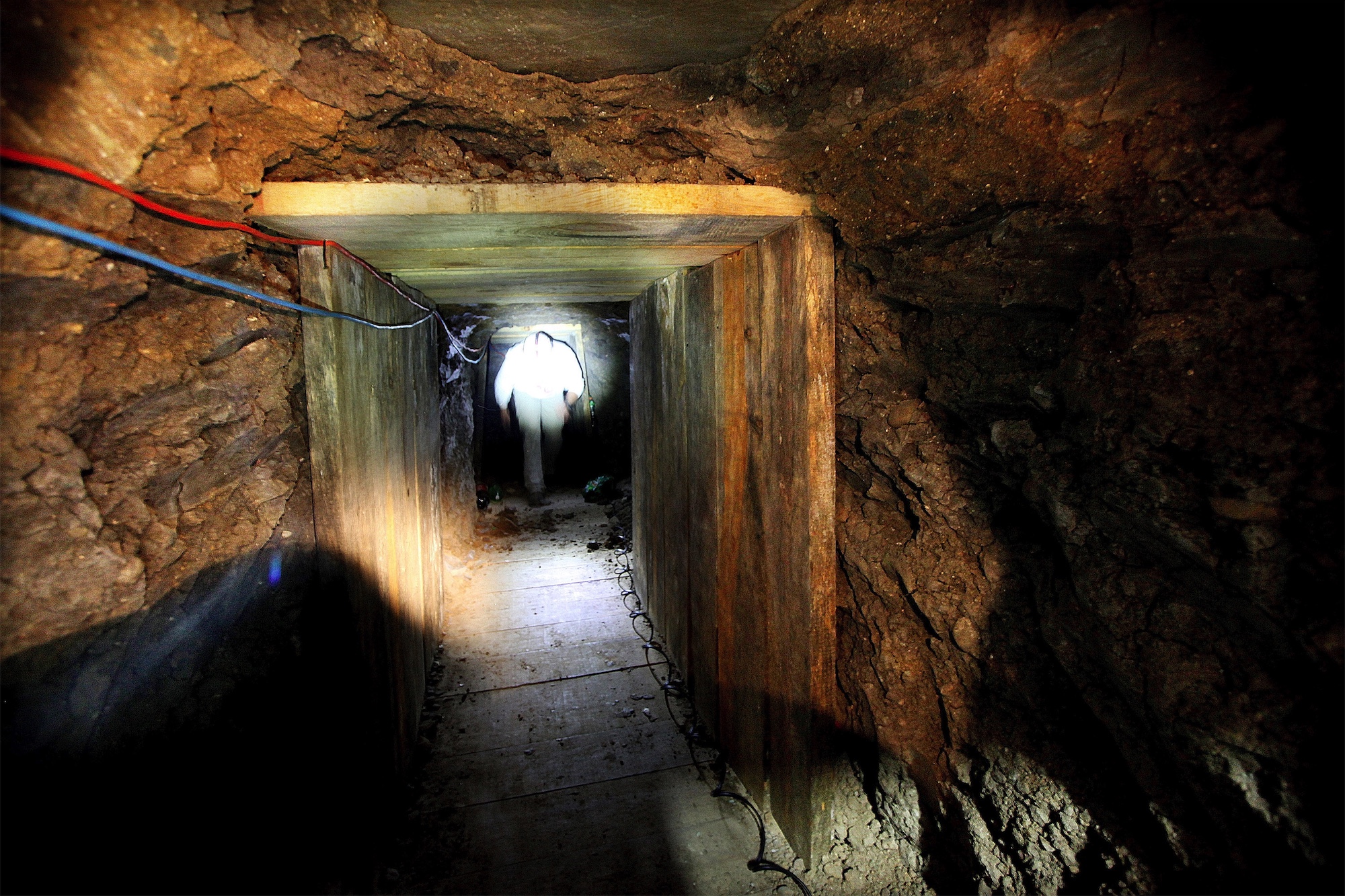
A tunnel between Tijuana and a warehouse in California featured an elevator. Getty Images
Why the wall wouldn't stop smuggling
Why the DHS believes that a thirty–human foot tall wall cannot be scaled and a tunnel cannot be congenital deeper than half dozen feet beneath ground is not clear.
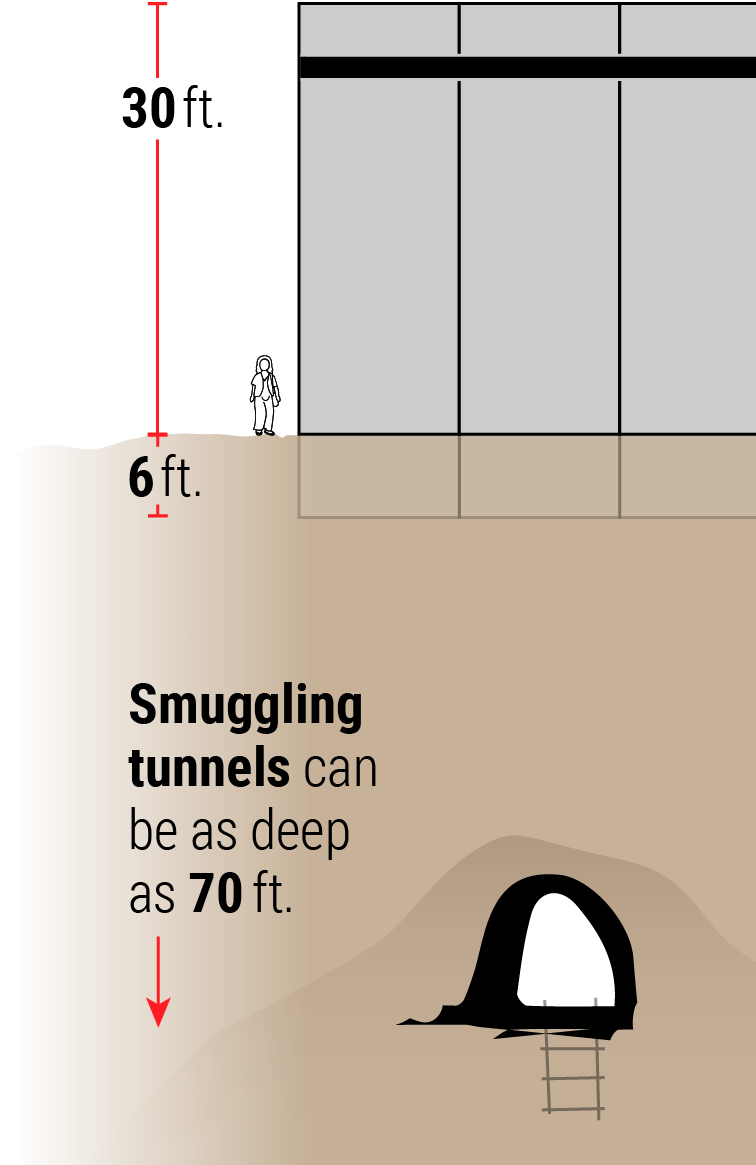
Drug smugglers have been using tunnels to get drugs into the Usa e'er since Mexico'southward most famous drug trafficker, Joaquín "El Chapo" Guzmán of the Sinaloa Dare, pioneered the method in 1989. And the sophistication of these tunnels has only grown over time. In April 2016, U.South. law enforcement officials discovered a drug tunnel that ran more than half a mile from Tijuana to San Diego and was equipped with ventilation vents, rails, and electricity. It is the longest such tunnel to exist plant so far, but i of 13 of great length and technological expertise discovered since 2006. Altogether, between 1990 and 2016, 224 tunnels have been unearthed at the U.S.–Mexico border.
Other smuggling methods increasingly include the use of drones and catapults every bit well every bit articulation drainage systems between border towns that have broad tunnels or tubes through which people can crawl and drugs can be pulled. But even if the land edge were to become much more secure, that would simply intensify the trend toward smuggling goods every bit well equally people via boats that sheet far to the north, where they land on the California coast.
Some other thing to consider is that a barrier in the form of a wall is increasingly irrelevant to the drug merchandise as information technology is now practiced because most of the drugs smuggled into the U.S. from United mexican states no longer arrive on the backs of those who cross illegally. Instead, according to the U.S. Drug Enforcement Administration, most of the smuggled marijuana equally well every bit cocaine, heroin, and methamphetamines comes through the 52 legal ports of entry on the border. These ports have to process literally millions of people, cars, trucks, and trains every week. Traffickers hide their illicit cargo in secret, land–of–the art compartments designed for cars, or under legal appurtenances in trailer trucks. And they have learned many techniques for fooling the border patrol. Mike, a grizzled U.S. border official whom I interviewed in El Paso in 2013, shrugged: "The narcos sometimes tip us off, letting u.s. find a car full of drugs while they send six other cars elsewhere. Such write–offs are part of their business organisation expense. Other times the tipoffs are false. We search cars and cars, snarl up the traffic for hours on, and find cipher."
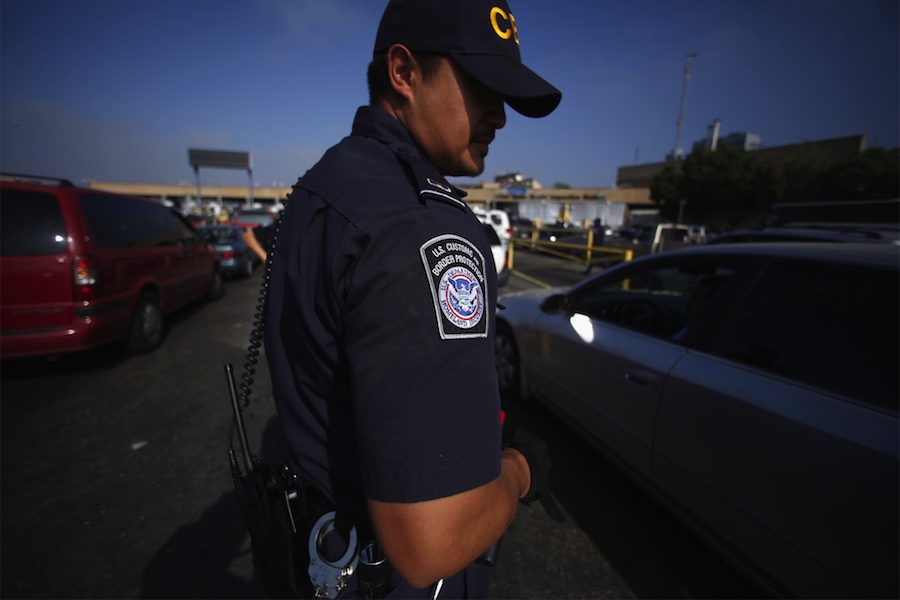
Across the Sinaloa Dare, 44 other significant criminal groups operate today in United mexican states. The infighting inside and among them has made Mexico one of the world'due south most violent countries. In 2016 alone this violence claimed between 21,000 and 23,000 lives. Between 2007 and 2017, a staggering 177,000 people were murdered in Mexico, a number that could actually be much higher, as many bodies are cached in mass graves that are hidden and never establish. Those Mexican border cities that are principal entry points of drugs into the Unites States have been particularly badly affected by the violence.
Take Ciudad Juárez, for example. Directly beyond the border from peaceful El Paso. Ciudad Juárez was likely the world's well-nigh violent city when I was there in 2011 and it epitomizes what can happen during these drug wars. In 2011 the Sinaloa Cartel was contesting the local Juárez Dare, trying to have over the city's smuggling routes to the United States, and causing a veritable bloodbath. Walking around the contested colonías at the time was like touring a cemetery: Residents would point out places where people were killed the day before, 3 days before, five weeks ago.









Juan, a skinny 19–twelvemonth–old whom I met there that year, told me that he was trying to exit of a local gang (the name of which he wouldn't reveal). He had started working for the gang equally a halcone (a lookout man) when he was 15, he said. But at present equally the drug war raged in the urban center and the local gangs were pulled into the infighting between the big cartels, his friends in the gang were being asked to practise much more than than he wanted to do—to kill. Without any grooming, they were given assail weapons. Having no shooting skills, they just sprayed bullets in the vicinity of their assigned targets, hoping that at least some of the people they killed would be the ones they were supposed to impale, because if they didn't succeed, they themselves might exist murdered by those who had contracted them to do the job.
I met Juan through Valeria, whose NGO was trying to help gang members like Juan get on the straight and narrow. Only it was tough going for her and her staff to make the case. As Juan had explained to me, a member who refused to practise the bidding of the gangs could be killed for his failure to cooperate.
"And America does cipher to end the weapons coming here!" Valeria exclaimed to me.

While President Trump accuses United mexican states of exporting trigger-happy crime and drugs to the United States, many Mexican officials as well as people like Valeria, who are on the ground in the fight confronting the drug wars, complain of a tide of violence and corruption that flows in the opposite direction. Some 70 percent of the firearms seized in Mexico between 2009 and 2014 originated in the United States. Although amounting to over 73,000 guns, these seizures still likely represented only a fraction of the weapons smuggled from the United states of america. Moreover, billions of dollars per year are made in the illegal retail drug market in the Usa and smuggled back to Mexico, where the cartels depend on this money for their basic operations. Sometimes, sophisticated money–laundering schemes, such equally trade–based deals, are used; but large parts of the proceeds are smuggled every bit bulk cash hidden in secret compartments and among goods in the cars and trains daily crossing the border due south to Mexico.
Some 70 percentage of the firearms seized in Mexico between 2009 and 2014 originated in the United States.
And of course it is the U.Due south. demand for drugs that fuels Mexican drug smuggling in the commencement place. Take, for example, the electric current heroin epidemic in the United states of america. Information technology originated in the over–prescription of medical opiates to treat pain. The subsequent efforts to reduce the over–prescription of painkillers led those Americans who became dependent on them to resort to illegal heroin. That in turn stimulated a vast expansion of poppy cultivation in Mexico, specially in Guerrero. In 2015, Mexico'due south opium poppy tillage reached perhaps 28,000 hectares, enough to dribble about seventy tons of heroin (which is fifty-fifty more than the 24–50 tons estimated to exist necessary to run into the U.S. demand).


United mexican states'southward large drug cartels, including El Chapo'south Sinaloa Cartel, which is estimated to supply betwixt 40 and threescore per centum of the cocaine and heroin sold on the streets in the United States, are the dominant wholesale suppliers of illegal drugs in the United States. For the retail trade, however, they usually recruit business partners among U.S. crime gangs. And thanks to the deterrence capacity of U.South. law enforcement, insofar as Mexican drug–trafficking groups do have in–state operations in the U.Southward., such as in wholesale supply, they accept behaved strikingly peacefully and take non resorted to the vicious aggression and infighting that characterizes their business organisation in United mexican states. So the U.S. has been spared the drug–traffic–related explosions of violence that accept ravaged so many of the drug–producing or smuggling areas of Mexico.
Both the George Westward. Bush administration and the Obama administration recognized the articulation responsibleness for drug trafficking between the U.s.a. and Mexico, an attitude that allowed for unprecedented collaborative efforts to fight crime and secure borders. This collaboration allowed U.S. constabulary enforcement and intelligence agents to operate in Mexico and assistance their Mexican counterparts in intelligence development, training, vetting, establishment of police force procedures and protocols, and interdiction operations. The collaboration also led to Mexico existence far more than willing than it ever had been earlier to patrol both its northern border with the Us and its southern edge with Key America, equally part of the effort to help apprehend undocumented workers trying to cantankerous into the United States.

The Trump administration's hostility to Mexico could jeopardize this progress. In retaliation for edifice the wall, for any efforts the U.Southward. might make to force Mexico to pay for the wall, or for the collapse of NAFTA, the Mexican government could, for instance, give up on its efforts to secure its southern edge or stop sharing counterterrorism intelligence with the U.s.a.. Yet Mexico's cooperation is far more than of import for U.S. security than whatsoever wall.

Chicago police at the scene of a shooting in the Englewood neighborhood. Getty Images
What the wall would mean for crime in the U.S.
Although President Trump has railed against the "carnage" of crime in the U.s., the law-breaking statistics, with few exceptions, tell a very different story.
In 2014, 14,249 people were murdered, the everyman homicide charge per unit since 1991 when there were 24,703, and part of a pattern of steady decline in violent crime over that entire period. In 2015, however, murders in the U.S. did shoot up to 15,696. This increase was largely driven by three cities—Baltimore, Chicago, and Washington, D.C. Baltimore and Chicago accept decreasing populations, and all three take college poverty and unemployment than the national average, loftier income and racial inequality, and troubled relations between residents and police—weather conducive to a rise in violent law-breaking. In 2016, homicides fell in Washington and Baltimore, simply continued rising in Chicago.
There is no evidence, however, that undocumented residents accounted for either the rise in crime or even for a substantial number of the crimes, in Chicago or elsewhere. The vast majority of tearing crimes, including murders, are committed by native–born Americans. Multiple criminological studies show that strange–born individuals commit much lower levels of crime than do the native–born. In California, for example, where at that place is a large immigrant population, including of undocumented migrants, U.S.–born men were incarcerated at a rate 2.5 times higher than foreign–born men.

Unfortunately, the Trump administration is promoting a policing approach that insists on prioritizing hunting down undocumented workers, including past using regular constabulary forces, and this kind of misguided law enforcement policy is spreading: In Texas, which has an estimated 1.5 million undocumented immigrants, Republican Governor Greg Abbott recently signed a police force to punish sanctuary cities. Among the punishments are draconian measures (such equally removal from office, fines, and up to one–year imprisonment) to be enacted confronting local constabulary officials who exercise not comprehend clearing enforcement. Abbott signed the law despite the fact that law chiefs from all five of Texas's largest cities—Houston, San Antonio, Dallas, Austin, and Fort Worth—published a statement condemning it: "This legislation is bad for Texas and will make our communities more dangerous for all," they wrote in their Dallas Morning time News op–ed. They argued that immigration enforcement is a federal, not a state responsibleness, and that the new law would widen a gap between police and immigrant communities, discouraging cooperation with police on serious crimes, and resulting in widespread underreporting of crimes perpetrated against immigrants. There is powerful and consequent prove that if people begin to question the fairness, equity, and legitimacy of law enforcement and government institutions, and so they stop reporting crime, and homicides increment.
Police force chiefs in other parts of the state, from Los Angeles to Denver, have expressed like concerns and as well their dismay at having to devote their already overstrained resource to hunting downward undocumented workers.
The Trump assistants has broadened the Obama–era criteria for "expedited removal." Nether Obama any immigrant arrested within 100 miles of the border who had been in the land for less than 14 days—i.eastward., before he or she could constitute roots in the Us—could be deported without due process. The result: In financial year 2016, 85 per centum of all removals (forced) and returns (voluntary) were of noncitizens who met those criteria. Almost all (more than xc percent) of the remaining 15 percent had been convicted of serious crimes.
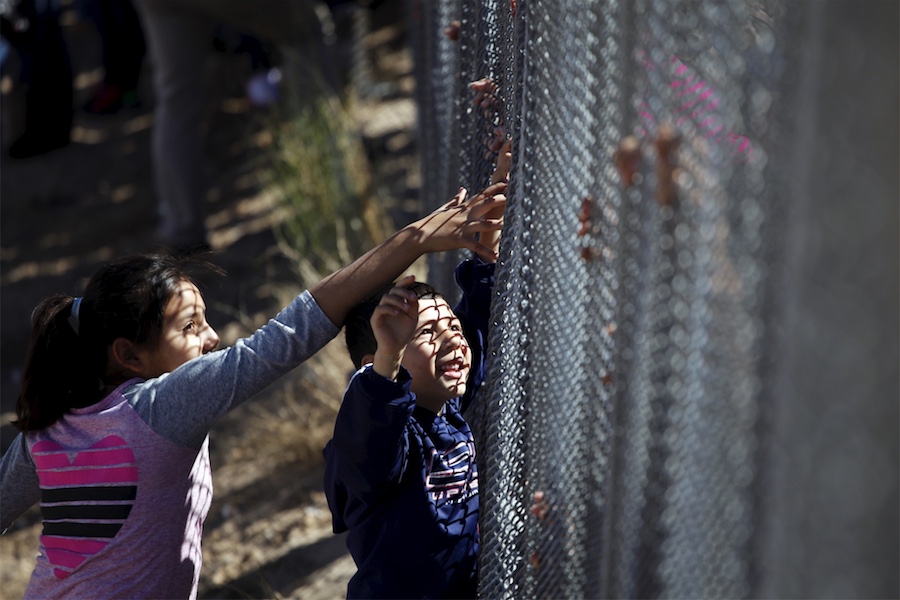
At present, however, any undocumented person anywhere in the country who has been here for as long equally two years can be removed. And although information technology claims it volition focus on deporting immigrants who commit serious crimes, the Trump administration is gearing upwards for mass deportations of many of the xi.1 million undocumented residents in the U.S., by far the largest number of whom come from Mexico (6.2 million), Guatemala, El Salvador, Honduras, Republic of ecuador, and Republic of colombia. To that end, information technology is vastly expanding the definition of what constitutes deportable crime, including fraud in any official affair, such equally abuse of "whatever program related to the receipt of public benefits" or fifty-fifty using a fake Social Security number to pay U.S. taxes. The Trump administration is also reviving the highly controversial 287(g) plan under which local constabulary enforcement officials can exist deputized to perform clearing duties and can inquire almost a person's immigration status during routine policing of matters as insignificant equally jaywalking.
Many of the people beingness targeted have for decades lived lawful, safe, and productive lives here. About 60 percent of the undocumented have lived in the Us for at to the lowest degree a decade. A third of undocumented immigrants aged 15 and older have at to the lowest degree i child who is a U.S. denizen by birth. The ripping apart of such families has tragic consequences for those involved, as I take seen offset–hand.
"Many of the people being targeted [for deportation] take for decades lived lawful, safe, and productive lives here."
Antonio, whom I interviewed in Tijuana in 2013, had lived for many years in Las Vegas, where he worked in construction and his wife cleaned hotels. Having had no encounters with U.S. law enforcement, he risked going back to Mexico to visit his ailing mother in Sinaloa. Just he got nabbed trying to sneak back into the U.S. After a legal ordeal, which included being handcuffed and shackled and a degrading stay in a U.S. detention facility, he was dumped in Tijuana, where I met him shortly subsequently his arrival there. He dreaded existence forever separated from his wife and their two lilliputian boys, who had been born seven and five years before. But Sinaloa is a poor, tough place to alive, strongly under the sway of the narcos, and Antonio did not desire his loved ones to sacrifice themselves in order to rejoin him. As Antonio high-strung back tears talking about how much he missed his family, I asked him whether they might travel to San Diego to speak with him across the bars of Friendship Park. But Antonio wasn't sure how long he could stay in Tijuana. He was afraid he would be arrested again, this time in Mexico, considering in order to please U.S. law enforcement officials by appearing diligent in combating crime, Tijuana's constabulary force had gotten into the habit of arresting, for the most minor of infractions, Mexicans and Central Americans deported from the U.s.a.. Sweeping homeless poor migrants and deportees off the streets fabricated Tijuana's city eye appear peaceful, bustling, and make clean again, afterward years of a cartel bloodbath. Mexican businesses were pleased by the orderly await of the city centre, the U.S. was gratified by Mexico's cooperation, and tourists were returning, with U.Due south. higher students again partying and getting boozer in Tijuana'south cantinas and clubs. If harmless victims of U.South. deportation policies similar Antonio had to pay the price for these benefits, and then be information technology.
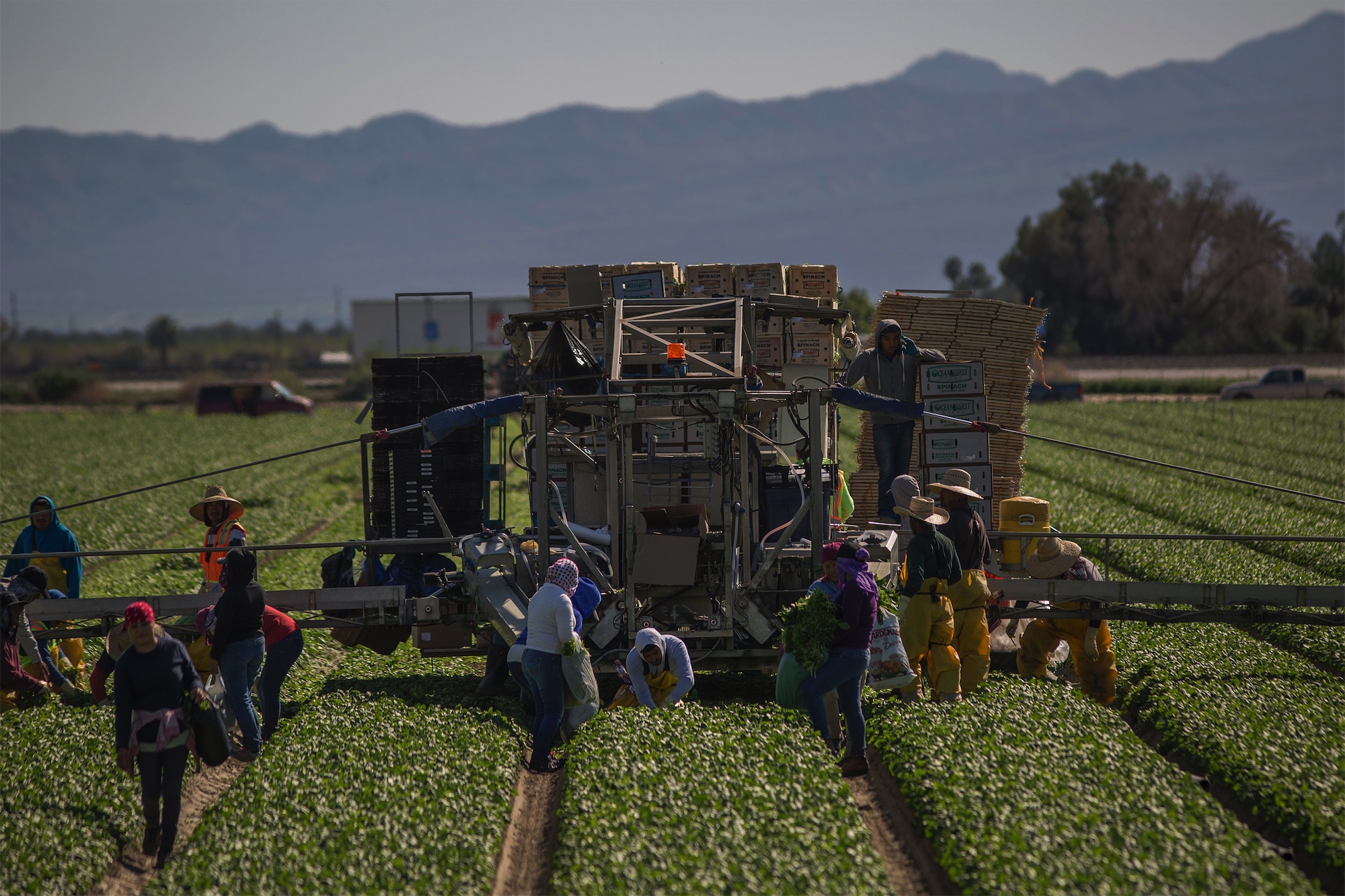
Immigrant farm workers harvest spinach virtually Coachella, California. Getty Images
How the wall would hurt the U.S. economic system
If immigrants are not responsible for any significant amount of crime in the Usa and in fact are considerably less probable than native–born citizens to commit crime, then what about the other justification for President Trump's vilification of immigrants, legal and illegal, and his determination to wall them out: Do immigrants steal U.Southward. jobs and suppress U.South. wages?
There is trivial prove to support such claims. According to a comprehensive National Academies of Sciences, Applied science, and Medicine analysis, immigration does not significantly bear upon the overall employment levels of well-nigh native–built-in workers. The impact of immigrant labor on the wages of native–born workers is also low. Immigrant labor does have some negative effects on the employment and wages of native–born high school dropouts, however, and also on prior immigrants, because all iii groups compete for low–skilled jobs and the newest immigrants are often willing to work for less than their contest. To a large extent, however, undocumented workers often work the unpleasant, dorsum–breaking jobs that native–born workers are not willing to practice. Sectors with large numbers of undocumented workers include agriculture, construction, manufacturing, hospitality services, and seafood processing. The fish–cutting manufacture, for case, is unable to recruit a sufficient number of legal workers and therefore is overwhelmingly dependent on an undocumented workforce. Skinning, deboning, and cutting fish is a smelly, slimy, grimy, chilly, monotonous, and exacting chore. Many workers rapidly develop carpal tunnel syndrome. It can be a dangerous job, with mechanism for cutting off fish heads and deboning knives everywhere frequently leading to amputated fingers. The hazard of infections from cuts and the encarmine h2o used to wash fish is as well substantial. Over the past ten years, multiple exposés accept revealed that both in the U.s.a. and away, workers in the line-fishing and seafood processing industries, often undocumented in other countries also, are subjected to forced labor weather condition, and sometimes treated similar slaves.
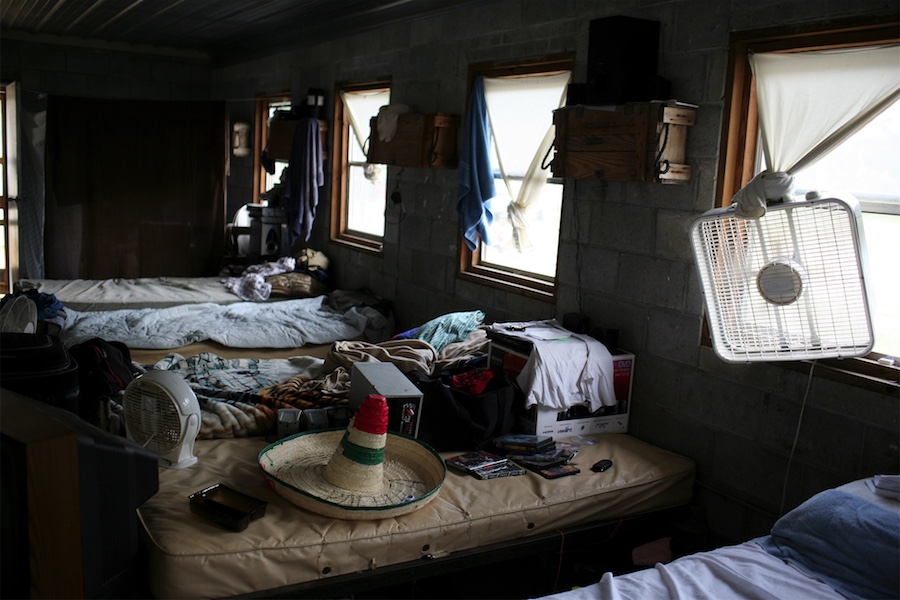
While paying more jobs she could obtain in Honduras, the fish cutting job was difficult for 38–year–erstwhile Marta Escoto, profiled by Robin Shulman in a 2007 commodity in The Washington Post. But she put up with it for the sake of her 2 immature children, one of them a 4–year–old daughter who couldn't walk and suffered from a gastrointestinal affliction that prevented her from absorbing enough nutrition. Even so the fright of raids to which the Massachusetts fish–cutting industry was subjected a decade agone, in an earlier wave of anti–immigrant fervor, drove her to seek a chore as a seamstress in a Massachusetts factory producing uniforms for U.S. soldiers. But misfortune struck there, as well. Like the seafood processing plants, the New Bedford factory was raided past U.S. immigration officers; and although Marta had no criminal record, she was arrested and quickly flown to a detention facility in Texas while her children were left solitary in a day care eye. Unlike many other immigrants swept upwardly in those raids, Marta was ultimately lucky: She had a sister living in Massachusetts who could recall her children. And every bit a result of big political outcry in Massachusetts following those raids, with Senators John F. Kerry and Edward 1000. Kennedy strongly speaking out against them, Marta was released and could reunite with her two small children. Just she remained without documents authorizing her to work and stay in the U.s.a. and would again be discipline to deportation in the future.
Estimated undocumented immigrant population
by state, 2014
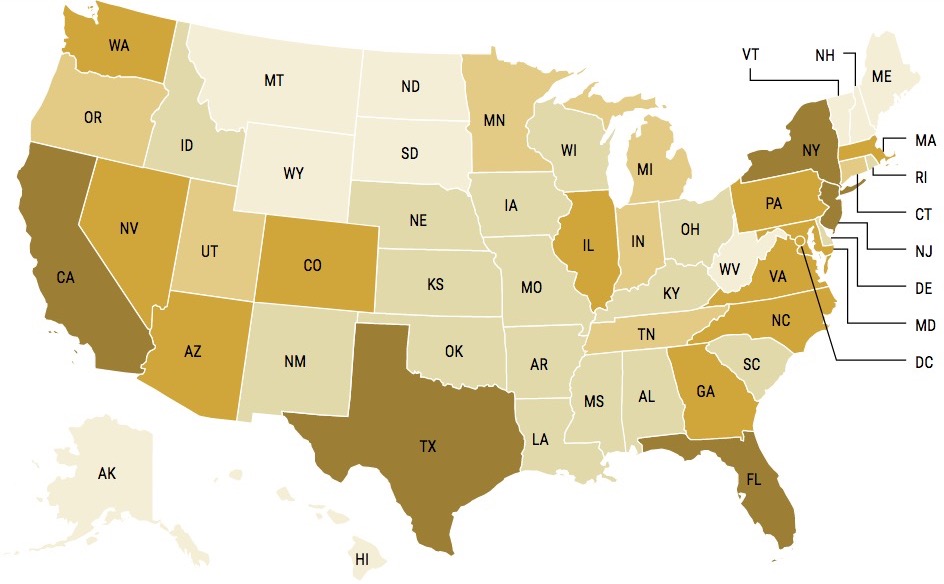
- x,000 or less
- 25,000 – 95,000
- 100,000 – 130,000
- 180,000 – 450,000
- 500,000 – 2,350,000
Immigrant workers are actually having a net positive result on the economy. Considering of a native–born population that is both declining in numbers and increasing in age, the U.South. needs its immigrant workers. The portion of foreign–born now accounts for about 16 percentage of the labor force, with immigrants and their children accounting for the vast bulk of current and time to come workforce growth in the United States, If the number of immigrants to the U.s. was reduced—by deportation or barriers to further immigration—so that foreign–born represented only about 10 percentage of the population, the number of working–age Americans in the coming decades would remain essentially static at the electric current number of 175 one thousand thousand. If, however, the proportion of foreign–born remains at the current level, so the number of working–age residents in the U.S. will increase by most 30 million in the next fifty years. Nosotros need these workers not but to fill jobs but to increase productivity, which has diminished sharply. We besides demand them considering the number of the elderly drawing expensive benefits like Medicare and Social Security—the costs of which are paid for by workers' taxes—is growing substantially. Nearly 44 million people anile 65 or older currently depict Social Security; in 2050 that number is estimated to ascension to 86 1000000. Fifty-fifty undocumented workers support Social Security: Since at to the lowest degree 1.8 one thousand thousand were working with fake Social Security cards in 2010 in order to become employment only were by and large unable to draw the benefits, they contributed $13 billion that year into the retirement trust fund, and took out but $i billion.

If immigrants are not stealing U.S. jobs and suppressing wages to any significant extent, is NAFTA doing so? Sal Moceri, a 61–year–old Ford worker in Michigan, fervently believes so. He has non lost his job himself, but he saw his co–workers and neighbors lose jobs and sees new workers accepting lower wages for which he would not settle. Although he calls himself a "lifelong Democrat," he voted for Trump in 2016 because of Trump's promise to renegotiate or end NAFTA. In a CNNMoney interview with Heather Long, he blamed NAFTA for the job losses and decreases in wages around him, disbelieving the claims of economists that automation, non NAFTA, is the source of the job losses in U.S. manufacturing. He loves automation and hates NAFTA.
But contrary to Trump'south claim and Moceri's passionate belief, NAFTA has non siphoned off a large number of U.S. jobs. Information technology did force some U.South. workers to notice other kinds of piece of work, but the net number of jobs that was lost is relatively pocket-sized, with estimates varying between 116,400 and 851,700, out of 146,135,000 jobs in the U.S. economy. Countering these losses is the fact that the bilateral trade fostered past NAFTA has had far–reaching positive effects on the economy.
The trade agreement eliminated tariffs on one-half of the industrial goods exported to United mexican states from the United States (tariffs which before NAFTA averaged x per centum), and eliminated other Mexican protectionist measures as well, allowing, for case, the export of corn from the Us to Mexico.
NAFTA has enabled the development of joint product lines betwixt the United States and Mexico and allows the U.Southward. to more cheaply import components used for manufacturing in the United States. Without this kind of co–operation, many jobs would be lost, including jobs provided by cars imported from Mexico. In 2016, for example, the Us imported 1.half dozen million cars from Mexico—but near 40 per centum of the value of their components was produced in the United States. Leaving NAFTA could jeopardize 31,000 jobs in the automotive industry in the United States solitary. Only now that it is threatened with the collapse or renegotiation of NAFTA, Mexico has already begun actively exploring new trade partnerships with Europe and China.
The big picture: Mexico is the 3rd largest U.South. trade partner later China and Canada, and the 3rd–largest supplier of U.Southward. imports. Some 79 percent of Mexico's total exports in 2013 went to the United States. Yes, the United States had a $64.3 billion deficit with Mexico in 2016, only merchandise with United mexican states is a 2–way street. The United states exports more to Mexico than to any other country except Canada, its other NAFTA partner. Moreover, the half trillion dollars in goods and services traded between Mexico and the U.s. each year since NAFTA was enacted over 23 years agone has resulted in millions of jobs for workers in both countries. According to a Woodrow Wilson Middle report, near 5 million U.Due south. jobs now depend on merchandise with Mexico.
Trade, investment, joint production, and travel across the U.S.–United mexican states border remain a way of life for border communities, including those in the U.s.a.. Disrupting them will create substantial economic costs for both countries. And a significantly weakened Mexican economic system volition also exacerbate Mexico's severe criminal violence and encourage violence–driven immigration to the United States.
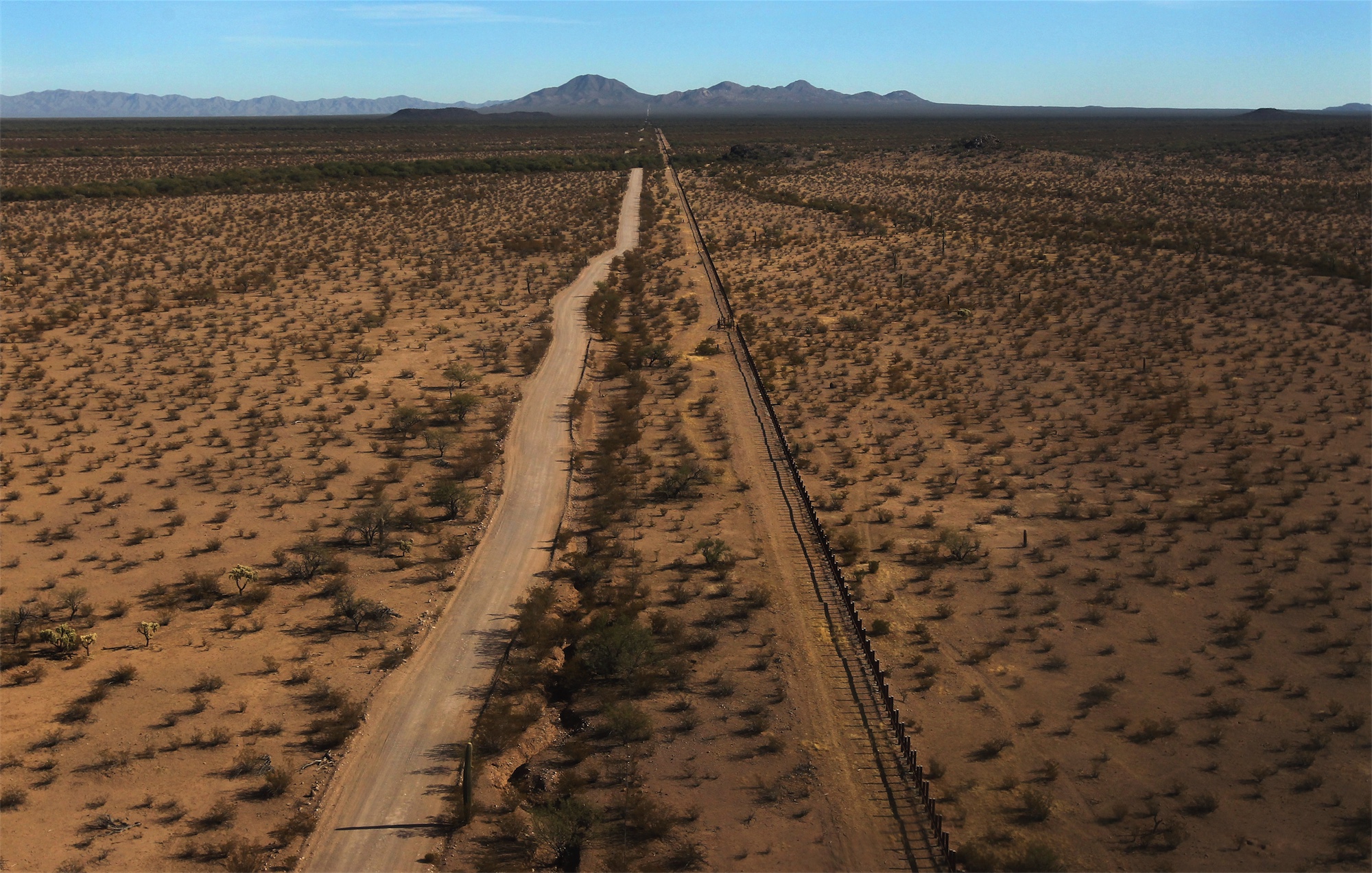
The U.S.-Mexico border fence through the Sonoran Desert, in the Tohono O'odham Reservation, Arizona. Getty Images
What the wall would do to communities and the environment
If erected, Trump's wall volition not be the first significant barrier to be built on the border. That distinction goes to the 700–mile fence the U.S. began to put up—over protests from those on both sides of the border—some years ago.
These people include 26 federally–recognized Native American Nations in the U.S. and eight Ethnic Peoples in United mexican states. The border on which the wall is to be built cuts through their tribal homelands and separates tribal members from their relatives and their sacred sites, while too sundering them from the natural environment which is crucial not just to their livelihoods but to their cultural and religious identity. In recognition of this trouble, the U.S. Congress passed an act in 1983 allowing free travel across the borders within their homelands to ane of the Native American Nations tribes. Only when the fence was built, past waiving statutes like the National Historic Preservation Act of 1966, the Native American Graves Protection and Repatriation Act of 1990, and the American Indian Religious Freedom Act of 1994, Congress compromised that freedom of travel and fabricated it difficult for indigenous people to visit their family members and sacred sites.
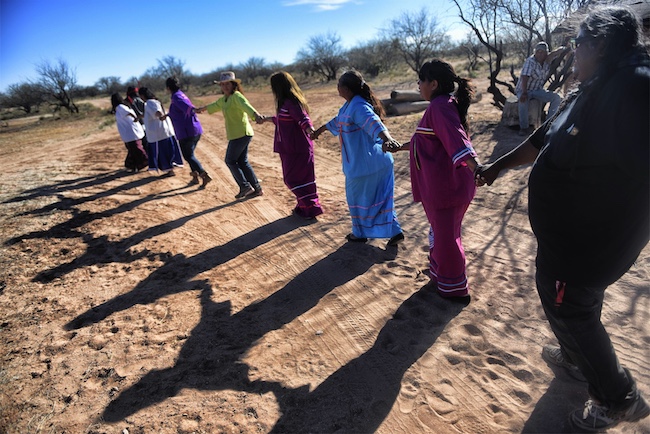
Trump's wall volition, of course, exacerbate the impairment to these Native American communities, causing keen pain and anger among the inhabitants. "If someone came into your business firm and built a wall in your living room, tell me, how would yous feel almost that?" asked Verlon Jose, vice chairman of the Tohono O'odham Nation, in an interview by The New York Times' Fernanda Santos in February 2017. Stretching out his arms to embrace the saguaro desert around him, he said, "This is our home." Many in his tribe want to resist the construction of the wall. Others fear that if the border bulwark is weaker on the tribal country, drug smuggling volition be funneled there as happened earlier with the debate, harming and ensnarling the community.
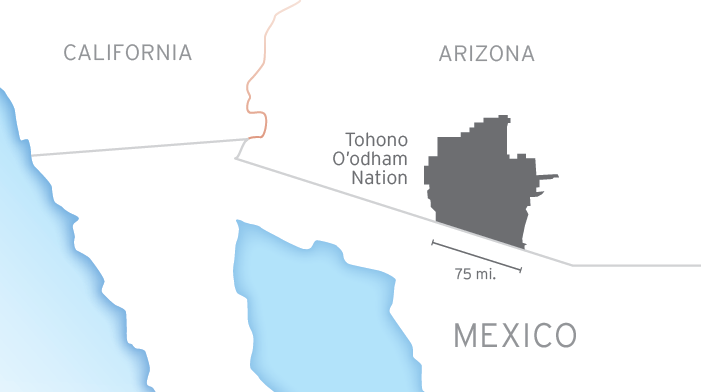
As Native American communities, conservation biologists, and the U.S. Fish and Wildlife Service all have highlighted, the wall will also have significant environmental costs in areas that host some of the greatest biodiversity in North America. Deriving its name from the isolated mountain ranges whose 10,000–foot peaks thrust into the skies, the "Sky Islands" region spanning southeastern Arizona, southwestern New Mexico, and northwestern United mexican states, for example, features a staggering array of flora and fauna. Its precious, but fragile, biodiversity is due to the unusual convergence of four major ecoregions: the southern terminus of the temperate Rocky Mountains; the eastern extent of the depression–acme Sonoran Desert; the northern edge of the subtropical Sierra Madre Occidental; and the western terminus of the higher–height Chihuahuan Desert. Among the endangered species that volition be affected by the wall are the jaguar, Sonoran pronghorn, Chiricahua leopard frog, lesser long–nose bat, Cactus ferruginous pygmy–owl, Mexican gray wolf, blackness–tailed prairie dog, jaguarondi, ocelot, and American bison. Other negatively–affected species will include desert tortoise, black acquit, desert mule deer, and a variety of snakes. Fifty-fifty species that tin can wing, such as Rufous hummingbirds and Swainson and Gray hawks could be harmed, and vital insect pollinators that migrate beyond the border could be burnt upwards by the lights necessary to illuminate the wall.

Altogether, more 100 species of animals that occur along the U.S.–Mexico border, in the Sky Islands area also as in the Big Bend National Park in Texas and in the Rio Grande Valley, are endangered or threatened. Only just as the DHS waived numerous cultural protection statutes to build the argue, it too overrode many crucial environmental laws—including the Endangered Species Human activity of 1973, the Migratory Bird Treaty Act of 1918, the National Environmental Policy Act of 1970, the Coastal Zone Management Act of 1972, and the Make clean Water Human activity of 1972. The Trump administration wants to bulldoze through whatsoever remaining ecology considerations.

The administration's arroyo threatens years of binational environmental border cooperation that has protected not only many wild species, but also agriculture on both sides of the border. Take the boll weevil, a beetle that flies between Mexico and the United States and devastates cotton fiber crops. In the late 1890s, the boll weevil almost wiped out the U.Due south. cotton industry. Since and then, the Us and Mexico have spent decades trying to eradicate the pest and well-nigh succeeded. Merely the wall may so sour U.Southward.–Mexico environmental and security cooperation that Mexico may simply give upwardly on eradication efforts. This will cause little damage to those in Mexico, since at that place is little cotton cultivation along that part of the Mexican border, but it will result in significant impairment to U.S. farmers.
A poisoned U.S.–Mexican human relationship could also prevent the renegotiation of h2o sharing agreements that are critical to the environment as well as to water and food security, and to farming. For case, the 1970 Boundary Treaty between the U.s.a. and Mexico specifies that officials from both the U.S. and United mexican states must agree if either side wants to build any structure that could bear upon the flow of the Rio Grande or its alluvion waters, water that is vital to livestock and agriculture forth the edge. The fence was built despite Mexico'due south objections to it, and because its steel slats become clogged with debris during the rainy season, it has caused floods affecting cities and previously protected areas on both sides of the edge, resulting in millions of dollars in amercement.
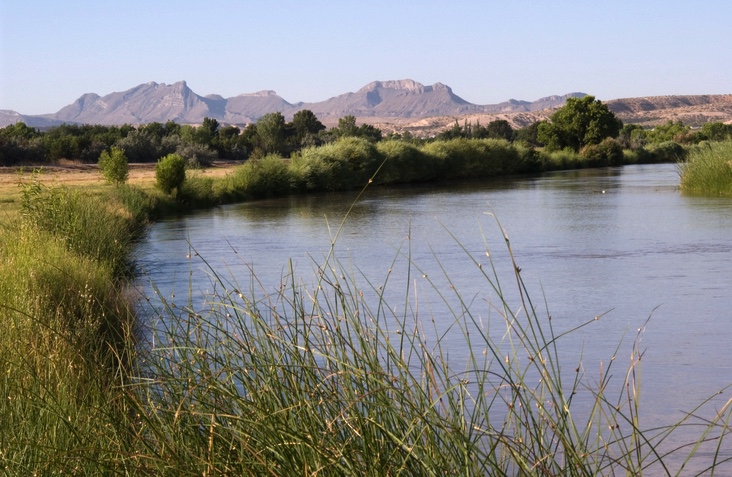
It wasn't simply Mexico that didn't want that fence. U.S. farmers and businessmen along the Texas border in the Rio Grande valley opposed it, also, since information technology blocks their access to the river water and also augments the severity of floods. Now the wall is to be brought to flood evidently areas in Texas where h2o issues precisely like these had prevented the construction of the fence earlier.
Meanwhile, manufacturing, agriculture, hydraulic fracking, energy product, and ecosystems on both sides of the border depend on equitable and effective water sharing from the Rio Grande and the Colorado River, with both sides vulnerable to water scarcities. Over the decades at that place have been many challenges to the joint agreements governing water usage, and both Mexico and the U.S. have at times considered themselves the aggrieved parties. Only in general, U.S.–Mexico cooperation over both the Rio Grande and Colorado rivers has been infrequent by international standards and has been hugely beneficial to both partners to the various treaties. That kind of co–performance is now at risk.
U.S.–Mexico cooperation over both the Rio Grande and Colorado rivers has been infrequent by international standards and has been hugely beneficial to both partners
If in retaliation for the Trump administration'due south vitriolic, anti–Mexican language and policies, Mexico decided not alive up to its side of the water bargain, U.South. farmers and others along the Rio Grande would be under severe threat of losing their livelihoods. One of them is Dale Murden in Monte Alto, who on his xx,000–acre farm cultivates sugarcane, grapefruit, cotton wool, citrus, and grain. Named in January 2017 the Citrus King of Texas, the erstwhile Texas Farm Agency state managing director has dedicated his life to agriculture in southern Texas, relying on a Latino workforce. Yet he has memories of devastating water shortages in 2011 and 2013, when because of a astringent drought Mexico could not send its allocation of the Rio Conches to the United States and thirty pct of his land became unproductive, with many crops dying. At that time he hoped that the U.South. Land Section could persuade United mexican states to release some water, even as Mexican farmers were likewise facing immense water shortages and devastation. U.S. affairs did piece of work, no doubtfulness helped by the rain that replenished Mexico's tributaries of the Rio Grande. Without the rain, United mexican states would non have been able to pay dorsum its accumulated water debt. But without collaborative U.S.–Mexico affairs and an atmosphere of a closer–than–ever U.Southward.–Mexico cooperation, Mexico withal could have failed to evangelize the water despite the rain. That positive spirit of cooperation also produced ane of the world's nearly enlightened, environmentally–sensitive, and h2o–use–savvy version of a h2o treaty, the so–chosen Minute 319 of the 1944 Colorado River U.S.–Mexico water agreement. Unique in its recognition of the Colorado River delta as a h2o user, the update committed the United States to sending a and so–called "pulse menstruum" to that ecosystem, thus helping to restore those unique wetlands. The United states of america likewise agreed to pay $xviii one thousand thousand for water conservation in Mexico. In turn, Mexico delivered 124,000 acre–anxiety of Mexican water to Lake Mead. It was a win–win–win: for U.S. farmers, Mexican farmers, and ecosystems. But those were the good days of the U.Due south.–Mexico relationship, before the Trump administration. A new update to the treaty is under negotiation—once again a vital agreement and a lifeline for some 40 meg people on both sides of the border that could autumn casualty to the Trump assistants's approach to Mexico.
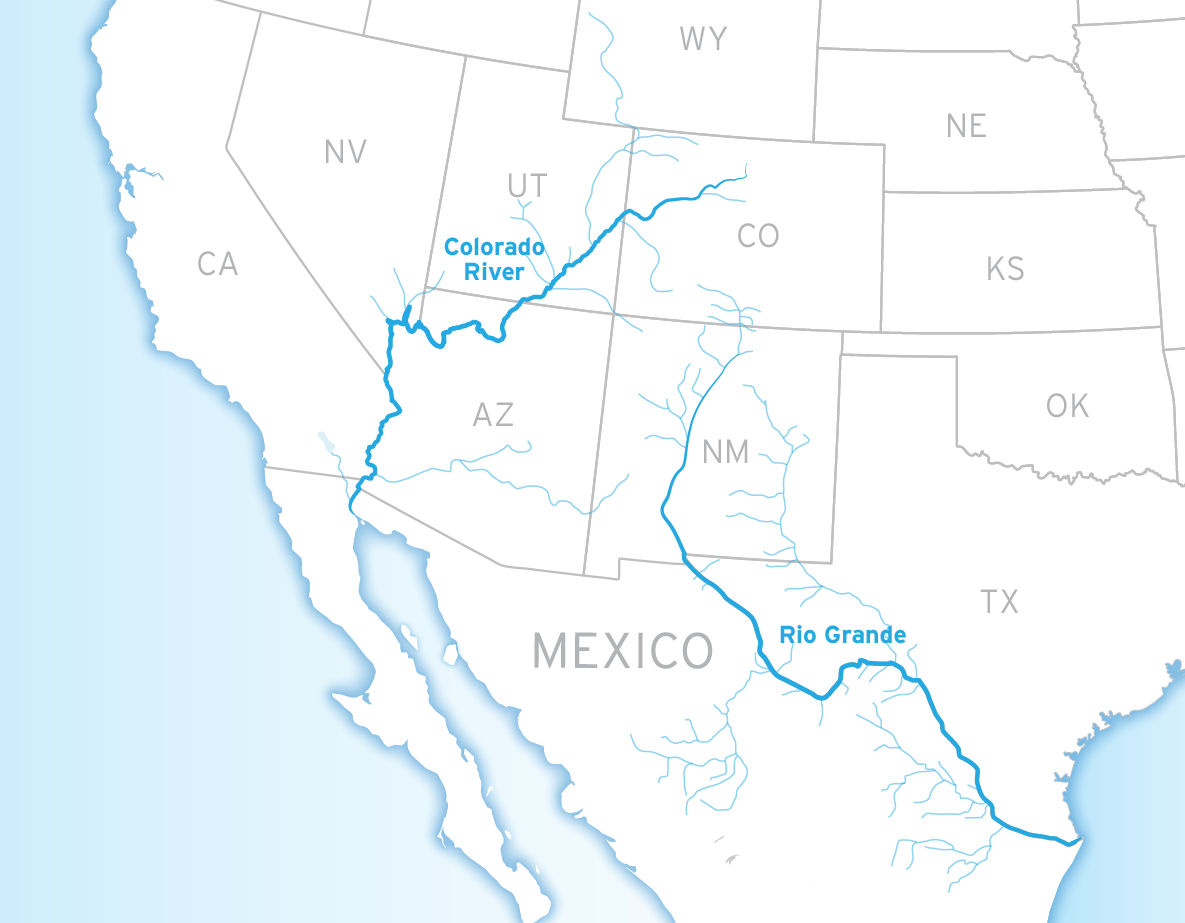
All the same this is a moment when maintaining cooperation is crucial because climate–change–increased evaporation rates, invasive plant infestation, and greater demands for water effectually the edge and deep into U.S. and Mexican territories volition only put further force per unit area on h2o use and increase the likelihood of severe scarcity.
Rather than a line of separation, the edge should be conceived of every bit a membrane, connecting the tissues of communities on both sides, enabling mutually benign trade, manufacturing, ecosystem improvements, and security, while enhancing inter–cultural exchanges.
In 1971, When First Lady Pat Nixon attended the inauguration of Friendship Park—that tragic place that allows separated families merely the most limited amount of contact—she said, "I hope there won't be a debate here too long." She supported 2–way positive exchanges between the Usa and Mexico, not barriers. In fact, for her visit, she had the fence in Friendship Park torn downwards. Unfortunately, it'south still there, bigger, taller, and harder than when she visited, and with the wall about to get much worse withal.
Source: https://www.brookings.edu/essay/the-wall-the-real-costs-of-a-barrier-between-the-united-states-and-mexico/

0 Response to "Mexicans Make It Clear Once Again How They Feel About Paying for Trumps â€ëœgreat Wall"
Enregistrer un commentaire